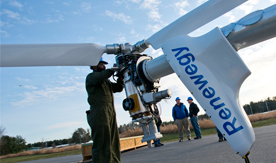
New Wave of Wind Energy
An offshore wind test turbine has been erected behind the University of Maine Advanced Structures and Composites Center on campus to evaluate sensor systems and controls in preparation for the installation of a floating turbine in the Gulf of Maine this spring as part of the DeepCwind Consortium project.
The temporary 1:8 scale wind turbine test site was installed Nov. 29 and will be in place for up to three months. Following a successful test, UMaine’s patent-pending VolturnUS test prototype will be placed off the coast of Maine in two locations in 2013.
Components of the floating turbine are being manufactured at the UMaine’s Advanced Structures and Composites Center, and will be shipped to Cianbro’s facility in Brewer, where the unit will be assembled including hull, tower, turbine and blades, and placed in the Penobscot River in a vertical position. The floating turbine unit will be towed down the river and moored at sea for testing to evaluate the technology and environmental impacts, and to collect data to validate design tools.
Once in the Gulf of Maine, the turbine will be the first grid-connected offshore turbine in the United States, marking a critical milestone for the development of floating turbine technology.
The demo project is designed to de-risk the technology and pave the way for private investment in a commercial scale-park by 2018–20, according to Habib Dagher, director of UMaine’s Advanced Structures and Composites Center.
The technology was tested in a wave-wind basin at the 1:50 scale in 2011.
Following a successful offshore test next year, a small 12-megawatt demonstration project consisting of two, 6-megawatt turbines is proposed for construction in 2015–17. A commercial-scale park, expected to be in the 500-megawatt range, will have more than 80 turbines in a space of 4 miles by 8 miles, and will be positioned more than 20 miles off shore, beyond the horizon.
“We’re here at the beginning of an exciting era that could create a whole new industry in our state, and reduce our reliance on imported fuels,” says Dagher.
UMaine President Paul Ferguson notes that the work of the Advanced Structures and Composites Center features a remarkable blend of student and faculty researchers, as well as public and private partners who characterize the University of Maine as a leading 21st-century research university.
“The center is poised to lead the transformation in deepwater offshore wind research,” Ferguson says.
The deepwater offshore wind research is a key transformative technology that the U.S. needs in order to compete globally, says Sen. Susan Collins, who has been instrumental in helping secure critical federal seed funding to advance the project’s R&D efforts.
“Maine has been at the forefront of deepwater floating turbine technology, and I am confident Maine will be at the forefront of making deepwater offshore wind a hallmark of U.S. innovation,” Collins says. “The Advanced Structures and Composites Center is developing cutting-edge research, providing an outstanding education for the next generation of engineers, and, best of all, spurring economic growth for our state and new jobs for our people.”
UMaine formed the DeepCwind Consortium with more than 30 commercial partners in Maine and beyond who are collectively working on prototype floating wind turbines. The Maine Ocean Energy Task Force has set a goal of producing 5 gigawatts of offshore wind by 2030. Building this 5-gigawatt network of floating offshore farms could attract nearly $20 billion of private investment to Maine and potentially create thousands of jobs, according to Dagher.
Funding for this DeepCwind program was received through competitive grants from the U.S. Department of Energy, the National Science Foundation Partnerships for Innovation program, the Maine Technology Institute, the state of Maine and the University of Maine. Additional funding was also received from UMaine’s private industry partners in the DeepCwind Consortium.
Contact: Elizabeth Viselli, 207.581.2831
